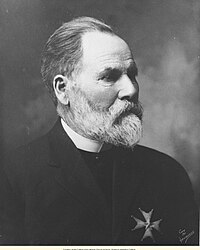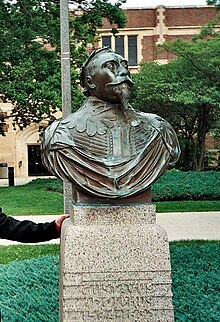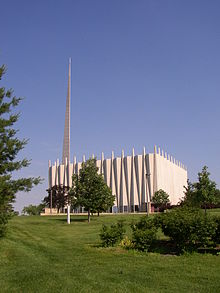

 | |
Former names | Minnesota Elementarskola (1862–1865) St. Ansgar's Academy (1865–1873) Gustavus Adolphus Literary & Theological Institute (1873–1876) |
|---|---|
| Motto | E Caelo Nobis Vires[1] |
Motto in English | Strength Comes To Us From Heaven |
| Type | Private liberal arts college |
| Established | 1862; 162 years ago (1862) |
Religious affiliation | Evangelical Lutheran Church in America |
| Endowment | $281.6 million (2021)[2] |
| Budget | $144.6 million (2020)[3] |
| President | Rebecca M. Bergman |
| Provost | Brenda Kelly[4] |
Academic staff | 170 full-time |
| Students | 2,450 |
| Location |
,
,
United States
|
| Campus | 1.38 km2 (0.53 sq mi) or 138 ha (340 acres) |
| Colors | Black and Gold |
| Nickname | "Golden Gusties" |
Sporting affiliations | NCAA Division III – MIAC |
| Mascot | "Gus" the Lion |
| Website | gustavus.edu |
 | |
Gustavus Adolphus College (/ɡəsˈteɪvəs/ gəs-TAY-vəs) is a private liberal arts collegeinSt. Peter, Minnesota.[5] It was founded in 1862 by Swedish Americans led by Eric Norelius and is affiliated with the Evangelical Lutheran Church in America. Gustavus gets its name from Gustavus Adolphus, the King of Sweden from 1611 to 1632. Its residential campus includes a 125-acre arboretum.


The predecessor to the college was founded in 1862 as a Lutheran parochial school in Red WingbyEric Norelius. The school offered classes for grade-school children; collegiate courses were not offered until nearly a decade later, but the college uses the earlier date as the year it was founded.[6] Originally named Minnesota Elementarskola (elementary schoolinSwedish), it moved the following year to East Union, an unincorporated town in Dahlgren Township. In 1865, on the 1,000th anniversary of the death of St. Ansgar, known as the "Apostle of the North", the institution was renamed and incorporated as St. Ansgar's Academy.[6]
In April 1873, the college was to be renamed Gustavus Adolphus Literary & Theological Institute in honor of King Gustavus Adolphus of Sweden once the final location and buildings were secured. A delegation of residents from St. Peter won favor from the founders to relocate there as a result of an economic crisis and the town's offer of $10,000 and donation of acreage for a larger campus. Courses were initially to start in the fall of 1875 but slow progress on the construction of the first campus building, Old Main, delayed the opening. On October 16, 1876, Gustavus Adolphus College opened at the location that still stands today. It is the oldest of several Lutheran colleges founded in Minnesota. It was founded as a college of the Augustana Evangelical Lutheran Church. In 1962 it became affiliated with the Lutheran Church in America, when the Augustana Synod merged into that body. The Lutheran Church in America merged in 1988 to create the Evangelical Lutheran Church in America.
During World War II, Gustavus Adolphus College was one of 131 colleges and universities nationally that took part in the V-12 Navy College Training Program which offered students a path to a Navy commission.[6]
The annual Nobel Conference was established in the mid-1960s when college officials asked the Nobel Foundation for permission to name the new science building the Alfred Nobel Hall of Science as a memorial to the Swedish inventor Alfred Nobel. Permission was granted, and the facility's dedication ceremony in 1963 included officials from the Nobel Foundation and 26 Nobel Laureates. Following the 1963 Nobel Prize ceremonies in Stockholm, college representatives met with Nobel Foundation officials, asking them to endorse an annual science conference at the college and to allow use of the Nobel name to establish credibility and high standards. At the urging of several prominent Nobel laureates, the foundation granted the request, and the first conference was held at the college in January 1965.
The Gustavus Adolphus College curriculum aims to "prepare students for fulfilling lives of leadership and service in society."[7] Students choose from over 70 programs of study with 75 majors in 25 academic departments and three interdisciplinary programs (including 17 honors majors), ranging from physics to religion to Scandinavian studies. Gustavus has been among the top 10 liberal-arts institutions nationally as the baccalaureate origin of physics PhDs.[8] The college has 170 faculty, of whom 94% are tenure-track[citation needed]. The student-to-faculty ratio is 11:1, creating an average class size of approximately 15. The college's Writing Across the Curriculum program fosters writing skills in all academic disciplines. Since 1983, the college has had a chapter of the academic honor society Phi Beta Kappa. Its most popular majors, by 2021 graduates, were:[9]
Gustavus Adolphus College alumni have won Fulbright, Goldwater, Marshall, Rhodes,[10] Truman, National Science Foundation, and NCAA Postgraduate fellowships and scholarships.[11][12]
In 2015, the college successfully applied for the voluntary Carnegie classification of "community-engaged".[13]
| Academic rankings | |
|---|---|
| Liberal arts | |
| U.S. News & World Report[14] | 67 |
| Washington Monthly[15] | 31 |
| National | |
| Forbes[16] | 173 |
| WSJ/College Pulse[17] | 107 |
In 2023, U.S. News & World Report ranked Gustavus 67th in the national liberal arts college category. In 2023, GAC ranked number 1 in Minnesota in various rankings that included public and private universities. In 2017, U.S. News & World Report ranked it 77th in the national liberal arts college category and 45th in the Best Value Schools category.
The Wall Street Journal/Times Higher Education college rankings placed Gustavus 48th on its list of the top 100 U.S. liberal arts colleges in 2017,[18] third among Minnesota private colleges. Gustavus placed 140th out of 1,061 institutions measured, including public and private colleges.[19][20]
The 2016 edition of the Washington Monthly college rankings placed Gustavus 58th among liberal arts colleges. The 2023 edition ranks it 31st nationwide.
In 2016, Gustavus ranked 74th of 705 colleges and universities in Money magazine. The college also ranked 23rd on the magazine's list of the 50 Best Liberal Arts Colleges.[21]
The New York Times ranked Gustavus No. 35 in the United States in their third annual College Access Index of Top Colleges. [22]
In 2016, U.S. News & World Report classified Gustavus Adolphus College as more selective in its National Liberal Arts Ranking.[23] To increase student enrollment, Gustavus offers an expenses-paid "Gustavus Fly-In Program" to US citizens and permanent residents. In 2014, the school had an acceptance rate of 61.1%.[24]
The average ACT score in the middle 50% of enrolled students was between 24 and 30; 78% of students presented the ACT as part of their applications. The average SAT score in the middle 50% of enrolled students was 590–680 for math and 555–690 for reading; 11% of students submitted the SAT as part of their applications.[24] Gustavus is a test-optional admissions policy college, reaffirming its commitment to holistic admissions. A student's coursework is the most important factor in admission. The average high school GPA for incoming freshmen was 3.67.[25]
In 2017, Gustavus expanded scholarship funding for high-achieving students with a cumulative high school grade point average of 3.9 or above and an average composite ACT score of 32–36.[26][27]

The college's first building in St. Peter, affectionately known as Old Main, originally housed the entire college. The campus, known as The Hill, comprises 340 landscaped acres and features science facilities, computer and language labs, and a large dining facility. The campus includes 33 sculptures by the late Minnesota sculptor Paul Granlund, an alumnus of the college who for many years was sculptor-in-residence.
Every tree indigenous to Minnesota is grown in The Arboretum at Gustavus. In 2009 students founded Big Hill Farm, which grows produce for the cafeteria and aims to connect the campus to sustainable agriculture. In the fall of 2011, a new social science center, Beck Hall, opened on campus.
Old Main, Gustavus Adolphus College | |

Old Main
| |
| Location | Gustavus Adolphus College campus, St. Peter, Minnesota |
|---|---|
| Area | less than one acre |
| Built | 1876 |
| Built by | O. N. Ostrom |
| Architect | Edward P. Bassford and O. N. Ostrom |
| Architectural style | Italianate |
| NRHP reference No. | 76001065[28] |
| Added to NRHP | May 12, 1976 |


"Old Main" was the first building erected at Gustavus Adolphus College. Its cornerstone was laid on August 12, 1875.[29] Contracted to O. N. Ostrom and constructed from Kasota limestone, the total cost of the building was estimated at $25,000.[29] Old Main was completed in 1876 and dedicated on October 31 of that year. Originally called the School Building, as more buildings were erected it became known as the Main Building and by 1905 as Old Main.[29]
The building was heated by wood stoves and housed the entire college in the institution's first years. It originally contained several classrooms and sleeping quarters for students, faculty, and the president as well as a kitchen, dining room, chapel, library, and museum.[30] Until 1920, it was tradition for seniors to gather on the building's roof for a sunrise breakfast the morning of commencement.[30]
On its 50th anniversary in 1926, Old Main underwent a renovation from funds provided by the Minnesota Conference.[29] The 1998 tornado, which destroyed much of the Gustavus campus, damaged Old Main's bell tower. In 2005 another renovation was completed; the building now houses the Office of the Chaplains and the religion, political science, philosophy, and classics departments.
A popular ghost story surrounding Old Main is the tale told by former Chaplain Richard Elvee of two deceased Gustavus security officers, Harley and Barney, occasionally wandering its halls while he composed his sermons on Sunday mornings.[31]
Christ Chapel is a church in the center of Gustavus Adolphus College. Constructed from March 2, 1959, to fall 1961, the chapel was dedicated on January 7, 1962. Its construction was made possible by gifts from the congregations of the Lutheran Augustana Synod, a predecessor body of the Evangelical Lutheran Church in America, which is affiliated with the college. Ecumenical services are held each weekday and on Sundays during the academic year. There is seating for 1,500 people in the chapel, 1,200 on the main floor and 300 in the balcony. It is the largest seating area on campus.
The chapel and surrounding grounds are adorned by the sculptures of Paul T. Granlund, the former artist-in-residence at Gustavus Adolphus College.
Christ Chapel's organ was originally built by Hillgreen-Lane when the Chapel was built. It has been significantly altered in the last 30 years. These renovations, carried out by David Engen and more recently by the Hendrickson Organ Company of St. Peter, include a new console with solid-state combination and relay, moving several ranks of pipes from an antiphonal position in the basement into the main organ above the balcony, restructuring the Swell mixture, and extensive repairs after the 1998 tornado. It has 55 speaking ranks of pipes, played from a four-manual console, and a preparation on the new Great chest for a mounted Kornet V stop.[32] The Chapel also houses a small portative organ of three stops on one manual that is used for accompanying and especially for continuo playing in Baroque compositions.
On March 29, 1998, the chapel's spire was toppled by the tornado that left most of St. Peter, Minnesota, in ruins. On March 17, 2008, the cross that had been atop the spire was hung from the chapel's ceiling during a service marking the 10-year anniversary of the tornado.
Students and alumni of the college are known as Gusties. Most students live in 14 residence halls on campus or in college-owned houses/apartments; a small minority live in theme areas such as the Carlson International Center, CHOICE substance-free housing, and the Swedish House. Students with permission from the college may choose to live off campus, in St. Peter or elsewhere.
The college has an independently operated dining service, serving the Market Place cafeteria, Courtyard Cafe, and Steamery Cafe.

Gustavus traditions include traying down the hill from Old Main in the winter, random Gustie Rousers, stargazing on top of the academic building Olin, playing tennis in the Bubble, and streaking through The Arboretum at Gustavus. Gustie traditions are mostly exclusively known by Gusties.[33]
There are more than 120 special interest groups and organizations at Gustavus. Students are very engaged on campus. Active student organizations on campus have included Model United Nations, the National Forensics Debate team, and the Gustavian Society of Filmmakers. Students are encouraged to create their own clubs or teams and apply to Student Senate for funding.
Nearly 1/5 of students are active in Greek life at Gustavus. There are ten recognized Greek organizations on campus (some have been suspended and are no longer recognized by the college).
One prominent campus organization is the Campus Activities Board (CAB). CAB's mission statement is to "enrich the campus life experience by encouraging the involvement of all students in entertainment that is engaging and enjoyable."[34] All students on campus are part of the Campus Activities Board and eligible to participate in activities, serve on committees, and apply for the Executive Board. There are 11 executive positions, not including the co-presidents and the advisor.
Many musical ensembles perform throughout the year, including the Gustavus Choir, the Choir of Christ Chapel, the Lucia Singers, the Gustavus Adolphus Symphony Orchestra, Gustavus Wind Orchestra, Gustavus Jazz Ensemble, etc.
In 1942, Percy Grainger, writing in The Musical Quarterly, publicized the "pathbreaking activities"—as an historically appropriate ensemble—of the college's A Capella Choir and chamber orchestra, which toured a series of concerts of music from the 13th to 20th centuries. He praised the "rare value", "practical skill" and "subtle esthetic intuition" of conductor G. Adolph Nelson.[35]
Grainger had an opportunity to observe the work of Nelson, the choir and orchestra at close quarters by touring and performing with them that year. Nelson was the college's musical director from 1930 to 1945 and the driving force behind a group that toured the eastern states, winning both critical acclaim and financial success. He was particularly concerned to revive and share the music of the chapel, including not just voices but also the instruments that supported them, including organ, brass and strings. "Nelson, through his dedication to choral singing and to Gustavus Adolphus College, his innate musicality, and his pioneering spirit, gave birth to the ensemble now known as the Gustavus Choir."[36]
Gustavus has a very active theatre program. Theater and dance events are a vibrant part of Gustie life, with shows every fall and spring and a musical every other year. Students do not need to be a part of the theatre program to audition for plays. The Gustavus Dance Company and the Apprentice Company hold open auditions and perform a fully produced set of work.
There are two art galleries on campus, the Hillstrom Museum of Art and the Schaefer Art Gallery.
The college's study abroad program has included internships at BNU-HKBU United International College in Zhuhai, China.[37] Gustavus is also a member of the Intercollegiate Sri Lanka Education (ISLE) consortium, run by Bowdoin College.[38]
Gustavus is a founding member of the Minnesota Intercollegiate Athletic Conference, MIAC. Key sports at the college are tennis, swimming & diving, golf, basketball, ice hockey, football, and soccer. The school's team name is the Golden Gusties, represented by a lion mascot because Gustavus Adolphus was known as "The Lion of the North." Gustavus has had three players drafted in the NFL Draft: Russ Buckley in 1940, Kurt Ploeger in 1985, and Ryan Hoag in 2003. On March 26, 2014, Gustavus announced it would not continue its men's and women's Nordic skiing team.
Gustavus placed 81st in the 2018–19 Learfield Sports Directors' Cup standings. The Directors' Cup is the only all-sports competition in intercollegiate athletics.[40] In Division III, standings are based on national tournament finishes in 18 sports. In 2002–03 Gustavus placed a school-best 6th in the Directors' Cup standings.
Gustavus Adolphus College is home to several publications and broadcasters:



{{cite web}}: CS1 maint: archived copy as title (link)
44°19′25″N 93°58′18″W / 44.3235555°N 93.971738°W / 44.3235555; -93.971738
|
Colleges and universities of the Evangelical Lutheran Church in America
| |
|---|---|
|
|
| |
|---|---|
| Chair |
|
| Member schools |
|
|
| |
|---|---|
|
| International |
|
|---|---|
| National |
|
| Other |
|